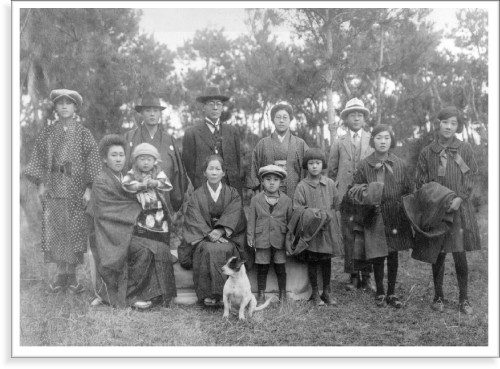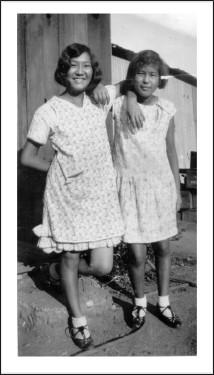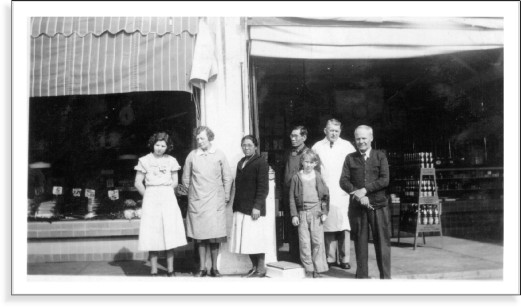Jimmy Makino's story is fascinating not for one specific experience, detail, or event,
but because through him, his family, friends and the communities he has been part of, his story
captures the panorama of the Japanese-American experience in the 20th Century: picture brides,
truck farms, internment camps, kibei, "no-no boys", the 442nd, citizenship for the Issei, and
restitution for the internees. This is not to say that strikingly different viewpoints aren't
available elsewhere for any of the events that touched Jimmy's life. There are and we invite you
to explore those different and equally valid voices. We would like to thank Jimmy though, for
devoting his life in "retirement" by acting as a docent and outreach educator to help others learn from his living history as well as for offering his story so that we may present it here.
In addition to this story, we would also like to direct you to the story of the Yamamotos, two Japanese-American girls who lived in Japan during the Pacific War, and our humble, but growing companion pages of documents and other referential material dealing with Japanese-American history in the 20th Century.
![[Issei: The Pre-War Years]](pix/makino/sub1.jpg)
My wife and I are Nisei. That's second generation Japanese-Americans. My father, Makino Toshio*, emigrated from Kumamoto in Southern
Japan, sometime in the earlier part of this century with his brother
[* Japanese names place the surname before the given name]. Like many Japanese immigrants
at the time, he first went to Hawaii, but left his brother shortly afterwards for the mainland where he stayed for
about five years in Seattle. He worked in Seattle doing housework while attending school. One day
his employer put my father's hat on his head and pushed him out the door. My father thought he was
being fired, but then found out that it was "maid's day" and he was being given the day off.
He learned to read and write pretty well for his generation of immigrants.
In 1907, the Gentleman's Agreement was passed between the U.S. and Japan.
As part of this agreement, Japan agreed to restrict the flow of Japanese men to America. There was no mention of female immigrants in the agreement, and the
restrictions against interracial marriages, both social and legal, led to the proliferation of
proxy marriages (kankodan). Marriages were concluded after letters
and photos were typically exchanged between the man in America and his bride-to-be in Japan.
My mother, Maketa Toshiye, married my father this way. These marriages, though recognized in Japan, were not recognized in
America, so the formal marriage ceremony had to take place immediately after the ship carrying
the bride arrived in port. The lonely Japanese men in America, in search of a wife were not
always completely honest. It was not uncommon for older men to send photos back to Japan that
they had taken years earlier, when they were more attractive. And so, my mother-in-law was
shocked when she saw her new husband for the first time because he had aged some eighteen years
beyond the likeness of the man she had been expecting to see after her long journey from Japan.
Women such as my mother and mother-in-law were known as "picture brides".

The MAKINO FAMILY during trip to Japan, 1925
(front, l-r) mat. aunt with child, grandmother, Jimmy, Ann, Mary, Holly; (back, l-r) 1 & 2-unknown, Toshio, Toshiye and maternal uncle.
 |
My parents had first met in the Napa-Sonoma area of Northern California, where my father was working in the hop fields.
My two older sisters, Helen and Mary, were born there before they moved to Southern California where my father owned a succession of
small stores in the 1920's and 30's. My sister Anna and myself were born in the
back of one of these stores where my mother was assisted by a midwife. My mother tried to instill
some Japanese values and traditions in us, but I think there was some ambivalence and these lessons
wore off as we got older. My sisters and I were all given Japanese and American names. My Japanese
name is Yukio, Helen's Japanese name is Harui, Mary's name is Kikuye and Anna's name is Yoshiko.
My parents were Buddhists, they burned incense on a counter, but they did not practice any religion
actively. I can only remember going to a Buddhist temple once as a child and that was for a funeral.
They would also sing some Japanese songs, do the New Year's mochi bit and eat Japanese food.
Our family even visited Japan for about nine months around 1924/25, but I was far too young to remember anything
of significance about the trip. We had Japanese
friends and there was some sense of community amongst us, but it was mostly loose and informal. I studied
Japanese as a boy, but didn't excel because I was busy playing around too much. I also took up kendo, a martial art
centered around a modified bambo stick used in place of a sword. I reached the level of shodan or
1st degree black-belt (higher numbers reflect increased levels of expertise). In high school, I joined a
school organization called the 3 O's, or the Three Orientals because its membership consisted of Chinese, Japanese, and Korean students, but I can't
remember anything specific that we did.
|
We were encouraged by mom and pop to speak English. This way we could be of more
help out at the store where the customers were all Caucasians. Only one occasion
of obvious racism sticks out in my mind from those pre-war years. I attended Alhambra
High School and played football. Most of the boys on the team were Italian-Americans
though there were a couple of Mexican boys and there was another Japanese-American in addition to myself. One day our
team decided to go swimming at a municipal swimming pool in Long Beach. As we were entering,
someone who worked at the pool picked me out of the group and told me, "You can't swim here."
My teammates rallied behind me though and said they wouldn't swim there if I wasn't
permitted to swim with them and we left. | |

All-American Girls:
Mary Makino and Hanako ("Hana")
 |
|
When the Depression hit, we were affected, but probably no worse than others. Instead of owning a
small store, my father now "owned" the vegetable section of a larger market. Being an Issei, he
was not eligible to become a citizen of the United States and California had begun passing laws
aimed at the Issei so they could not own real property. As a result, he owned the vegetable section at the
market, but not legally, and we only rented the homes we lived in before the war. I would go with
my pop to L.A.'s City Market, a large market where Japanese-American truck farmers would sell their
produce. He would go around the market, make a deal and leave a piece of paper at the food stall. I'd spend much of my time playing with the sons of the truck farmers at the market. Then we'd drive through the market and I'd help load up a truck with everything we bought.

Las Tiendas Market, San Marino, California
Toshiye and Toshio Makino with and others.
 |
Before World War II, Japanese truck farms were a way of life in the San Fernando-Burbank area,
El Monte, and South San Gabriel Valley. These farmers owned two-to-five acre lots on which they grew
different crops at different times of the year. My wife's family grew carrots where Studio
City sits today. Lettuce, strawberries and tomatoes were raised at a truck farm near Santa Anita
Racetrack. Celery was raised at a track farm near Long Beach. Another family raised asparagus,
rhubarb and cabbage on their truck farm at San Gabriel Blvd., where freeway 60 now meets freeway
10. The family name was Ito. Jim Ito's family was later interned at Heart Mountain, Wyoming
during World War II.
After school, many of the kids my age from these truck farms would go to work on the farms or
drive the trucks that connected them to the market. I was more fortunate because my father
owned the produce department of a market and when I had to work after school it was only to
deliver groceries around the San Marino area.

